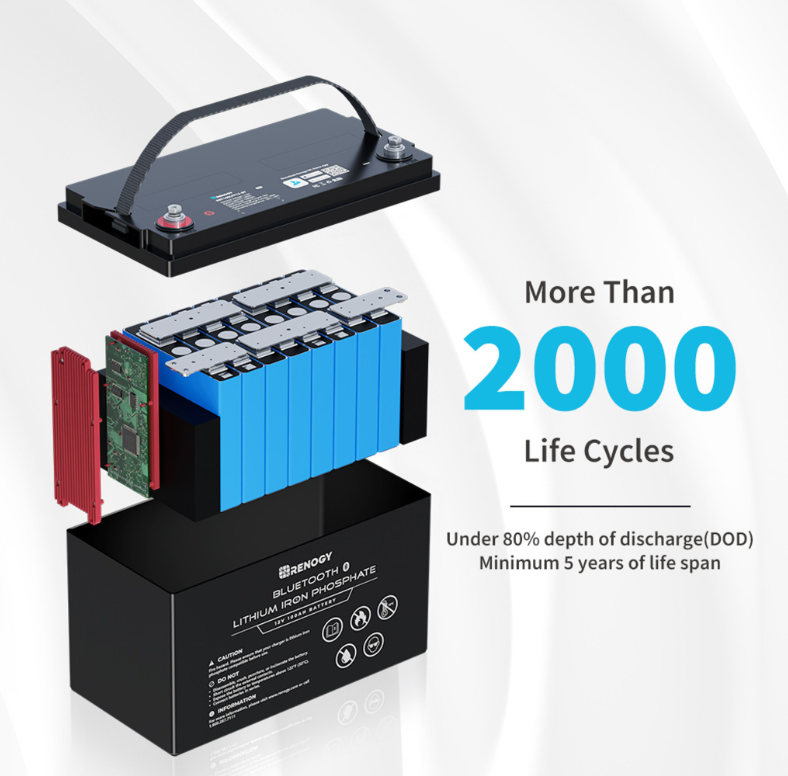Install a lithium battery in the camper


Factories supplying RV lithium batteries are still rare. The starting point for most will therefore be a mobile home with conventional battery equipment. 1-2 AGM batteries with a total capacity of 200Ah are typical.
Of course, there are a few things to consider when installing:
- There must of course be enough space for the new battery. New designs for mounting under the seat help a lot here.
- Battery charger must offer the right voltage and charging curve. Many RV chargers do not offer a lithium setting. Many retrofit solutions for lithium batteries for motorhomes are plug & play and work with them, but it is advisable to take a closer look before buying.
- A charge booster makes sense with lithium batteries, but retrofitting can be a bit tricky. More on that in the next section.
If you take the charging technology into account, you can easily convert to a 12v lithium battery yourself if you choose a plug & play solution. Remove the old battery, install a new one, possibly set the chargers to the battery type – done.
Which chargers are needed for a lithium battery?
There is quite a lot of uncertainty as to whether the charging technology installed in the mobile home is sufficient for an upgrade to lithium. It’s mostly about
- Charging with a shore power charger
- Charging with an alternator or charging booster on the go
- Charging with a solar charge controller
The important thing here is the end-of-charge voltage, which must not be too high and should not be too low either (so that the battery is also full).
A suitable charging characteristic is helpful for correct charging.
Charging lithium batteries using the shore power charger
Whether a charger is suitable for charging a lithium battery depends first of all on whether the end-of-charge voltage is suitable. In addition, a suitable charging characteristic should be used. In chargers where you can configure battery types, both parameters are usually related. However, there are still many chargers that do not have a special lithium setting. This can then be used, but the charging characteristic then does not fit ideally.
Example: A Renogy lithium battery has an end-of-charge voltage of 14.2-14.6V.
Lead-acid batteries have an end-of-charge voltage of around 14.4V. A charger that is set up in this way also works for the lithium battery in our example.
AGM batteries have a higher end-of-charge voltage of 14.7-14.8V. If a charger is set up for this, the lithium battery must not be charged with it.
Gel batteries have an end-of-charge voltage of 14.1-14.4V. A charger that is set for GEL batteries is therefore also suitable for lithium batteries. The built-in electroblocks can also be exchanged for chargers with lithium mode, but this is quite complex. You have to decide for yourself whether you need the advantage of a suitable charging curve. Thanks to the solar panel systems, we rarely charge with shore power and will therefore simply use the GEL setting.
Another factor to consider here is the power of the charger. For lead-acid batteries, which cannot absorb that much electricity anyway, relatively weak shore power chargers are installed. With high-capacity lithium batteries, the slow charging process can be annoying and a replacement may be necessary. At least if you use shore power often, which is not the case with us.
Charging lithium batteries from the alternator
- Alternators usually charge with 14.2-14.4V, which is suitable for lead-acid batteries.
- A Renogy lithium battery has an end-of-charge voltage of 14.2-14.6V, so it is basically compatible with the end-of-charge voltage of the alternator.
However, an alternator will charge as it deems convenient for engine management without addressing the needs of lithium batteries. Depending on the other consumers, the current and voltage can fluctuate here, and with intelligent alternators it can even be the case that charging is not carried out at all if the alternator wants to leave “space” in the starter battery for an upcoming recuperation.
Then a charging booster helps to charge a lithium battery optimally (and faster!).
Do you need a charge booster for Lifepo4 batteries?
Charging boosters have already been recommended for Euro6 engines and newer vehicles, since the energy management often interfered unfavorably and prevented the body battery from being fully charged. Read More
However, charging boosters only provide the promised performance to a limited extent with conventional batteries, because lead-acid batteries often cannot do anything with the performance promised by charging boosters. They take up electricity slowly.
It’s different with lithium, and you can hardly avoid the charging booster:
- The alternator does not offer a suitable charging curve and voltage for a lithium battery.
- The lithium battery can absorb electricity faster than lead-acid batteries. First of all, without a charging booster you are wasting your potential, because it is very practical if you can fill up considerable power reserves in the battery even on short journeys. In addition, the high power consumption of lithium batteries can overwhelm EBL and cable cross-sections.
The Plug&Play solutions can also be charged directly using an alternator. However, the voltage fluctuates and a charging characteristic is not maintained, which is not conducive to the service life of the lithium battery. Also, lithium batteries absorb as much current as they can get. This can overload cable cross-sections and the EBL and lead to problems. We therefore consider a charging booster to be absolutely sensible when using lithium batteries in the mobile home.
Retrofitting a charging booster is basically not a big deal, but the existing isolating relay has to be shut down for this.
Charging lithium batteries by solar charge controller
Solar charge controllers come in all forms. Modern MPPT charge controllers, such as the Victron controllers we use, allow all battery parameters to be set precisely. This means that charging lithium batteries is no problem.
After the conversion, it is important not to forget the appropriate configuration, because the end-of-charge voltage of the AGM batteries installed beforehand would be too high for the lithium battery that follows, for example.
How much does a lithium battery for a mobile home cost?
A 100Ah lithium battery currently costs around $1000, although some models are now starting at less than that. There has been a significant drop in price over the past few years, and prices are now quite acceptable (considering durability and performance).
200Ah double (or quadruple, depending on whether one or two body batteries were installed) the usable capacity for many typical mobile homes. Here you typically have to reckon with around $2000.
You can save some money by choosing no-name products. These don’t have to be bad, but whether you want to take the risk is up to you.
Conclusion
A lithium battery is a useful upgrade for anyone who wants to travel independently for long periods of time. For those who primarily stop at the campsite, a lithium battery is not worth it due to its high price. However, freelancers, long-term travelers and travelers with increased power requirements on the go will appreciate the high capacities, fast charging and resilience to deep discharge of a lithium battery. For these travelers, the price is also put into perspective by the long period of use.








